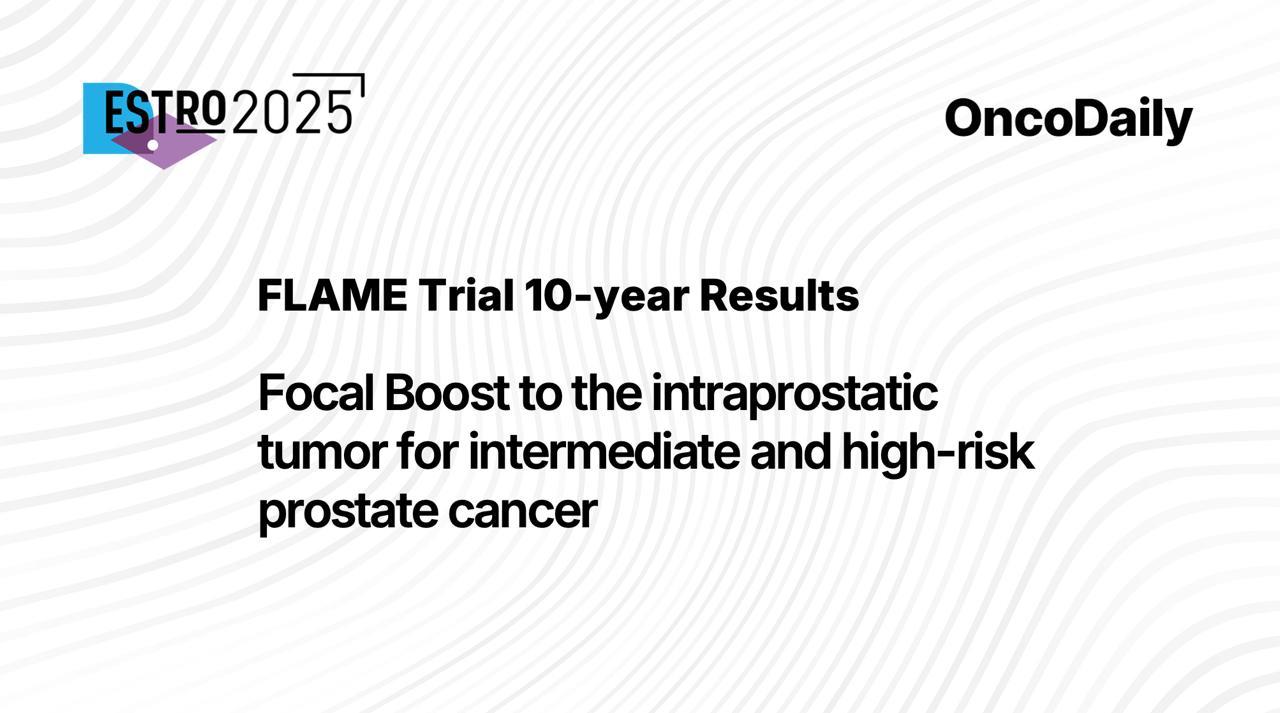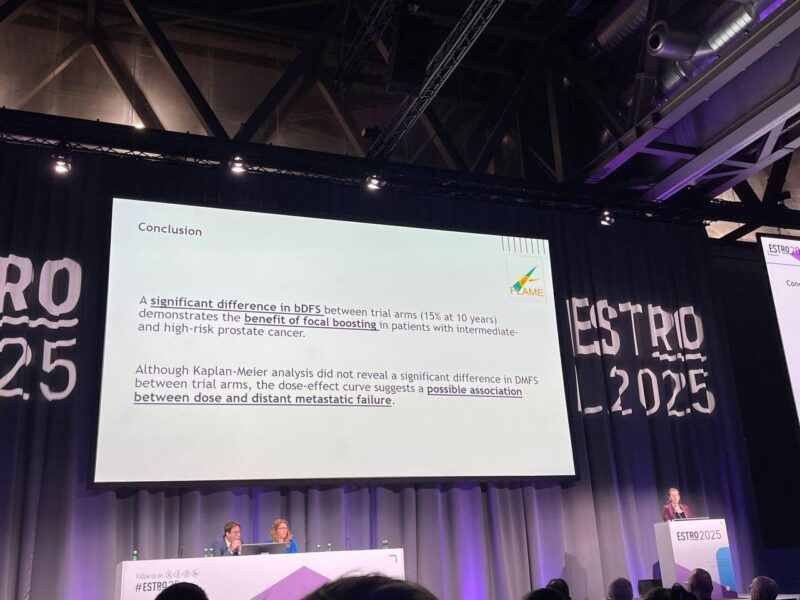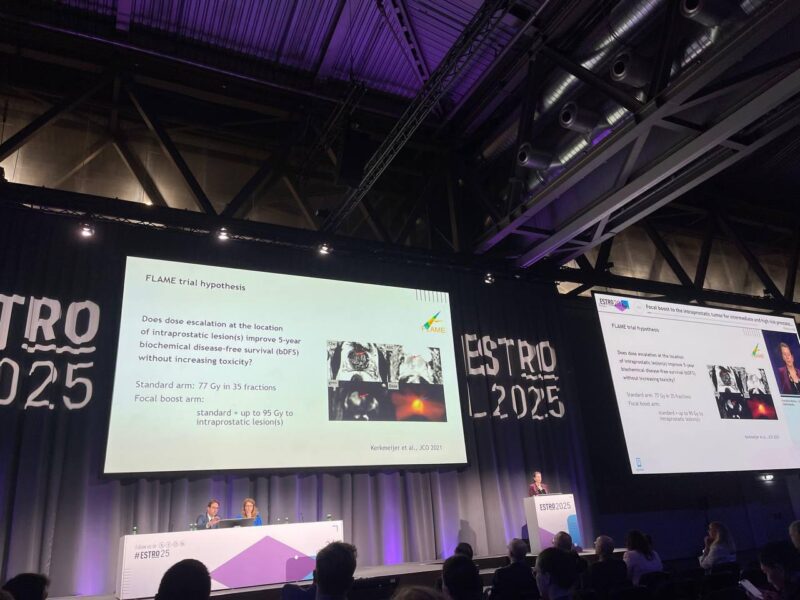
FLAME Trial at ESTRO 2025. Focal Boost to the intraprostatic tumor for intermediate and high risk prostate cancer: 10-year Results
Fresh from the podium at ESTRO2025! Karolina Manne-Guricova presented the 10-year outcome data from the FLAME trial, revealing long-term benefits of MRI-guided focal boost in radiotherapy for intermediate- and high-risk prostate cancer
External beam radiotherapy (EBRT) is a standard treatment option for patients with intermediate- and high-risk localized prostate cancer. While dose escalation to the whole prostate has shown improved biochemical control, it also increases the risk of genitourinary and gastrointestinal toxicity. Importantly, most local recurrences occur at the site of the dominant intraprostatic lesion, which can now be reliably identified with multiparametric magnetic resonance imaging (mpMRI). The FLAME (Focal Lesion Ablative Microboost in Prostate Cancer) trial was designed to test whether delivering a high-dose focal boost to the MRI-visible tumor within the prostate—while keeping the dose to surrounding normal tissue within safe limits—could further improve cancer control without increasing toxicity.
Methods
The FLAME trial was a multicenter, phase III, randomized controlled study conducted in the Netherlands. The study included 571 patients with intermediate- or high-risk localized prostate cancer, defined according to NCCN guidelines.
Patients were randomized into 2 arms
- Standard arm: 77 Gy in 35 fractions to the entire prostate
- Focal boost arm: Same as standard, with an additional simultaneous integrated boost (up to 95 Gy) to the MRI-defined intraprostatic lesion(s)
All patients received image-guided, intensity-modulated radiotherapy (IMRT), with mpMRI used for target delineation. Organ-at-risk (OAR) constraints were prioritized over achieving maximum boost dose.
Study Design
Primary endpoint of the FLAME trial was 5-year biochemical disease-free survival (bDFS), defined using the Phoenix definition (nadir PSA + 2 ng/mL)
Secondary endpoints were Local failure, distant metastasis-free survival (DMFS), overall survival (OS), toxicity (CTCAE v3.0), and quality of life (QoL, assessed via EORTC QLQ-C30 and PR25)
Follow-up included regular PSA testing and toxicity/QoL assessments over five years.
5 Year Outcomes of FLAME trial
After a median follow-up of 60 months, the FLAME trial yielded robust data on biochemical control, local failure, and safety outcomes. The results demonstrated a significant benefit in favor of the focal boost approach, without compromising patient safety or quality of life. Below, we summarize the key efficacy and toxicity findings that highlight the clinical impact of focal dose escalation in prostate radiotherapy.
Primary Outcome:
- bDFS at 5 years: 92% in the focal boost arm vs. 85% in the standard arm
- Hazard ratio (HR): 0.45; 95% CI: 0.28–0.71; p < 0.001
Secondary Outcomes:
- Local failure
- 2.8% (focal boost) vs. 5.3% (standard); HR: 0.54; p = 0.04
DMFS:
- 93% (focal boost) vs. 89% (standard); HR: 0.63; p = 0.13 (not statistically significant)
Overall survival:
- 91% (focal boost) vs. 86% (standard); p = 0.10
10 Year Outcomes of FLAME trial
For biochemical survival at 10 years, the dose-response data revealed that the biochemical failure rate at 77 Gy (the standard dose) was approximately 25%. However, at doses of 90 Gy or higher, the failure rate dropped to 5%, suggesting that higher doses to the GTV are crucial for improved outcomes.
Key Trial Outcomes
- Disease-Free Survival (DFS)-The focal boost arm had a 10-year bDFS of 81% compared to 67% in the standard treatment arm. This outcome showed a strong association between dose escalation and better survival, supporting the efficacy of focal boosting.
- Regional Control- For regional disease-free survival, there was a notable improvement in the focal boost arm, with 94% survival compared to 85% in the standard treatment arm. This suggests that focal boosting may provide additional benefits in controlling regional metastases.
- Distant Metastasis-Free Survival-While the Kaplan-Meier analysis showed no significant differences in distant metastasis-free survival, the dose-response curve indicated that a higher dose could improve this outcome, further warranting investigation into the role of dose escalation for reducing distant spread. 835at stadard arm vs 87% Focal boost arm
- Overall Survival (OS)-There was no significant difference in overall survival between the two groups, which may indicate that improvements in biochemical control and regional survival do not directly translate into better long-term survival.
Key Takeaways
- A significant difference in bDFS between trial arms (15% at 10 years) demonstrates the benefit of focal boosting in patients with intermediate-and high-risk prostate cancer.
- Although Kaplan-Meier analysis did not reveal a significant difference in DMFS between trial arms, the dose-effect curve suggests a possible association between dose and distant metastatic failure.


About ESTRO 2025
ESTRO 2025 brings together around 7,000 participants from over 80 countries, showcasing the latest research in clinical radiation oncology, radiobiology, medical physics, technology, and brachytherapy. Leading doctors and scientists from around the world present groundbreaking findings, in line with the conference theme: “Transformative innovation through collaboration”. ESTRO 2025 is the annual congress of the European Society for Radiotherapy and Oncology (ESTRO), an organisation dedicated to advancing cancer treatment through radiotherapy and multimodal approaches. ESTRO promotes education, science, and research and advocates for universal access to radiotherapy. With nearly 10,000 members worldwide, it supports radiation oncology professionals and the broader oncology community in their daily practice.
Read ESTRO 2025 Updates on OncoDaily.
-
Challenging the Status Quo in Colorectal Cancer 2024
December 6-8, 2024
-
ESMO 2024 Congress
September 13-17, 2024
-
ASCO Annual Meeting
May 30 - June 4, 2024
-
Yvonne Award 2024
May 31, 2024
-
OncoThon 2024, Online
Feb. 15, 2024
-
Global Summit on War & Cancer 2023, Online
Dec. 14-16, 2023
